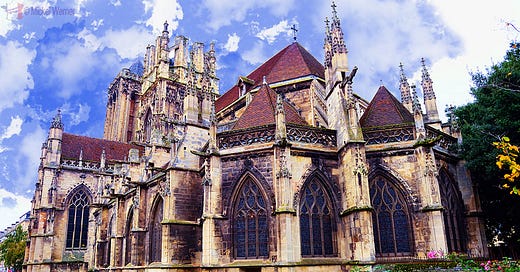The people of Caen place a great significance on their church life, making it a vital element of their community. Consequently, the city is dotted with a number of churches. Here's a glimpse at some of them:
Note: Click here to read our introduction to the city of Caen
Eglise Saint-Jean de Caen
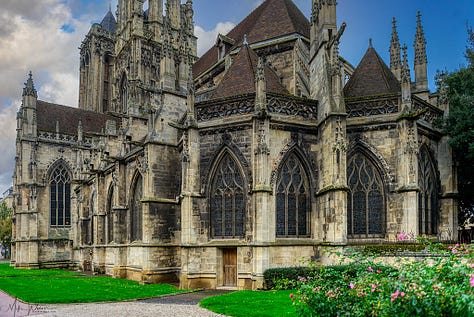

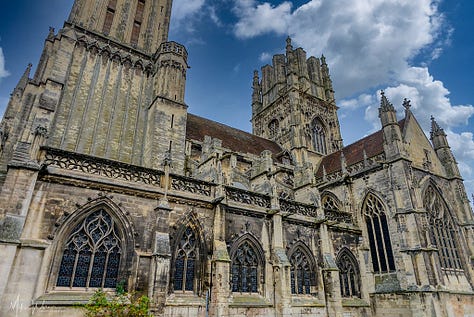
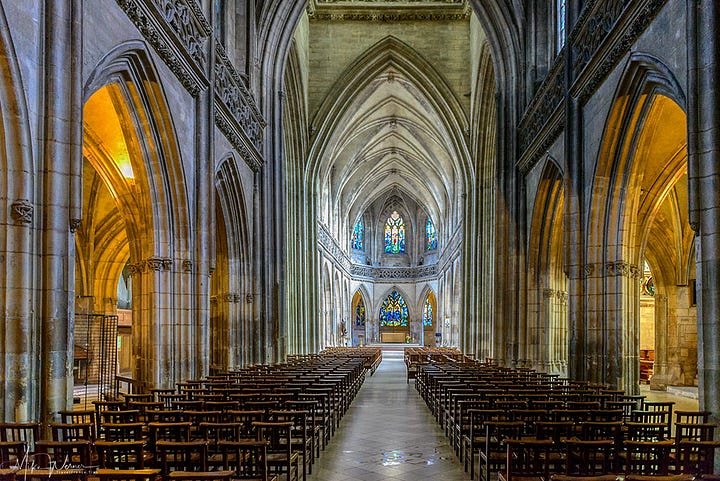
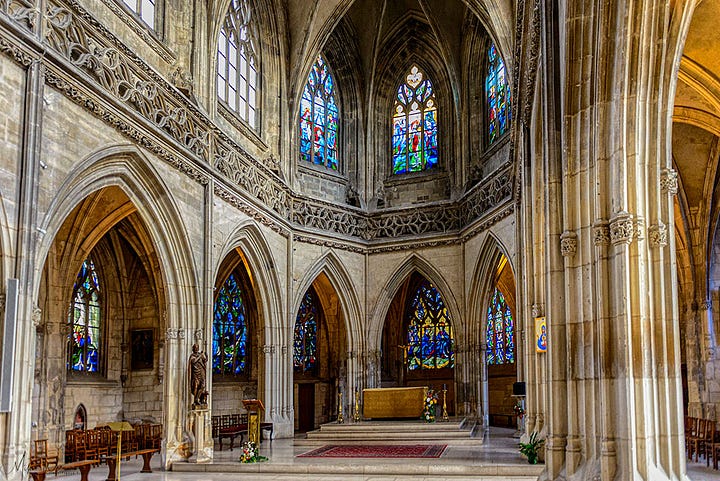
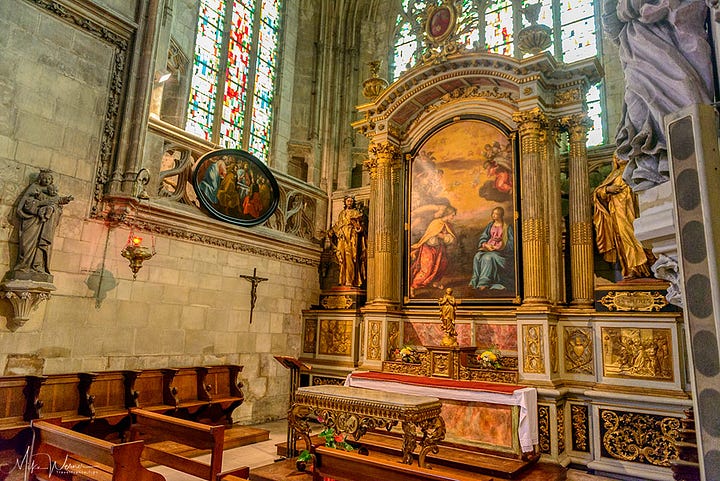
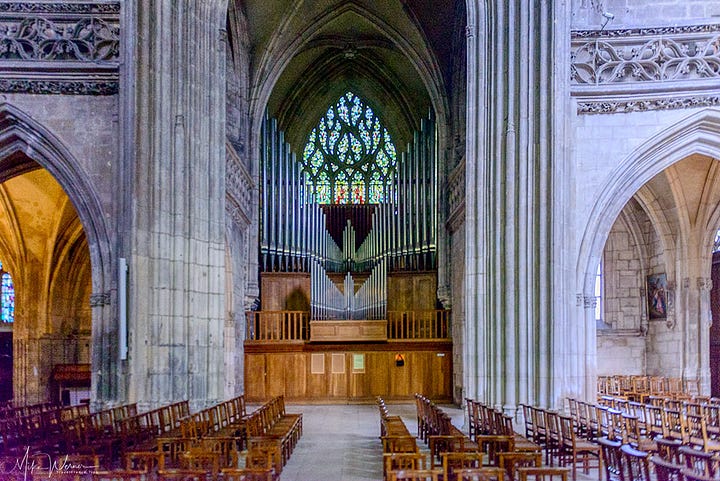
The Church of Saint-Jean de Caen, located in the Saint-Jean district of Caen, France, is a historical monument that was officially protected under French law in 1840. Its origins date back to the seventh century when the first place of worship was founded dedicated to the Apostle John. This site was strategically positioned on a Roman road that spanned the marshes of the lower valley of the Orne, linking Augustodurum (now known as Bayeux) to Noviomagus Lexoviorum (Lisieux). This road later became rue Exmoisine and is now known as rue Saint-Jean.
Between 1954 and 1956, monolithic sarcophagi made from Caen stone were unearthed during works at the church site. These findings point towards the likelihood of a small necropolis along the Roman road and an oratory nearby. Regrettably, no remnants of this pre-Romanesque sanctuary survive today.
This church is the Leaning Tower of Pisa of Caen; indeed, it's hard not to notice its slanted appearance. The tower-porch indeed leans towards the northwest (2.28 m in 1700) because the church was built on swampy ground within the Saint-Jean island.
The Saint-Jean de Caen Church is thus a place of historical and cultural significance, attesting to the long religious and architectural history of the area. Its origins and changes over time offer insights into the historical evolution of Caen, from its Roman roots to its current standing as a notable city in the Normandy region of France.
Click here to see where the Saint-Jean church is located on Google Maps
Eglise Saint-Sauveur de Caen
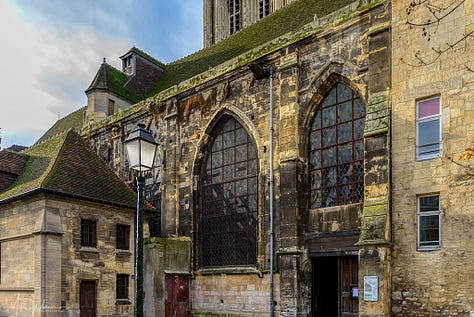
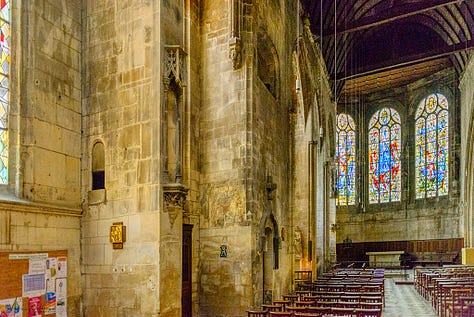
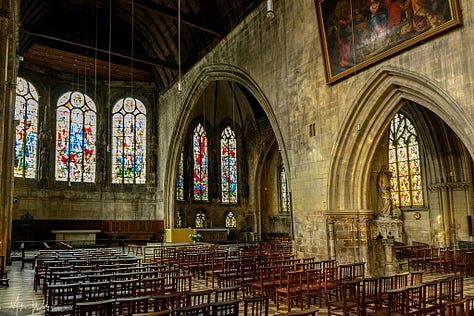
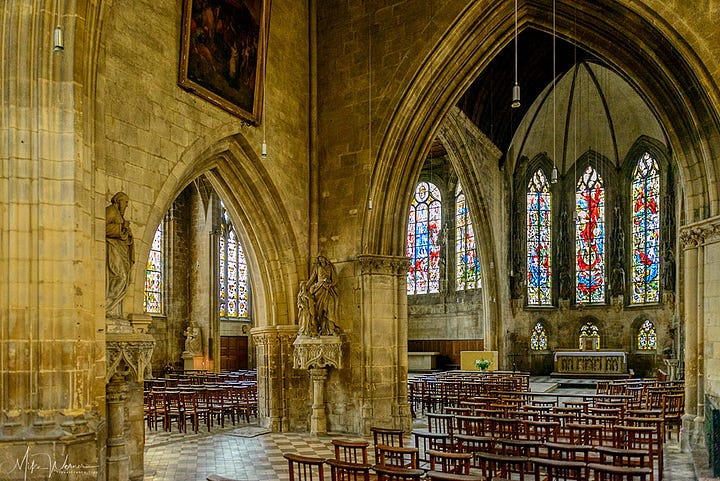
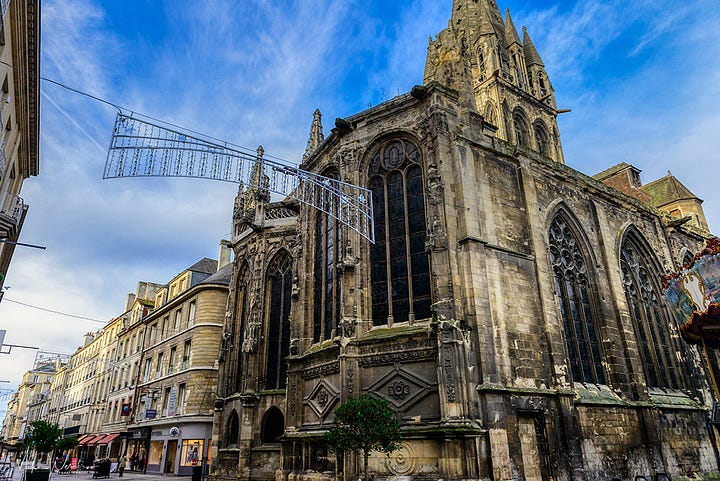
The Église Saint-Sauveur (Church of the Holy Savior), formerly known as the Church of Notre-Dame-de-Froide-Rue, stands in Caen. This church, situated in the city center, has undergone numerous modifications over the centuries, including changes to its name.
The Saint-Sauveur Church or Notre-Dame-de-Froide-Rue showcases architectural elements from various periods, dating back to the 11th century. Its structure demonstrates a mixture of Romanesque, Gothic, and Renaissance styles, presenting an interesting study for architecture and history enthusiasts.
The circumstances surrounding the founding of the church are not well known.
According to popular tradition, the Notre-Dame de Froide-Rue Church was established in the 7th century by Saint Regnobert. Every year, the feast of the former Bishop of Bayeux was celebrated as the founder of the parish. However, this tradition is only attested from the 16th century onwards.
Around 660, during his visit to the city, Saint Ouen is said to have deposited the relics of Saint Marcouf at Notre-Dame; inscriptions carved in a chapel would recall this event. Another tradition that emerged in the 18th century recounts the visit of Saint Marcouf himself to the church.
Of the possible original Romanesque building, no trace remains.
The first certain mention of the church does not precede 1152-1153 when it is mentioned in a papal bull by Pope Eugene III, confirming the assets of the Bayeux Cathedral. Of the Romanesque building mentioned in the 12th century, there is no trace left either. The church in its current configuration was assembled in three stages. The bell tower and the easternmost nave, dedicated to Saint Eustache, were erected in the 14th century. In the 15th century, the building was transformed into a hall church by adding a second nave extended by a three-sided apse opened by pointed arch windows; a large Gothic arch was then pierced, and the base of the tower was remodeled to integrate it inside the building. The portal opening onto Froide Street and the carved wooden door that closes it also date from this period. Probably shaken by the construction of the large arch separating the naves, the apse of the Saint Eustache nave was rebuilt in the 16th century; the foundations and full arch openings bear witness to this renovation in a Renaissance style, completed in 1546. Today, the church's ground area is 875 m2 (including the presbytery).
In 1153, the church was established as a prebend of the Bayeux Cathedral by Bishop Philippe d'Harcourt; the canon of Notre-Dame thus benefited from the patronage, collation, and deport of this church. In August 1323, Philippe VI allowed the parishioners to have their burial place, as the bodies of parishioners were until then buried in the cemeteries of other parishes. Houses near the church were purchased, and a cemetery was set up in their place, which was expanded in 1393. Until the Revolution, holy water was consecrated once a year in the baptismal fonts during the Epiphany feast; this practice, common in several Eastern churches, had been banned from Catholic worship during the Council of Rouen in 1072.
On December 30, 1775, an earthquake struck the city of Caen. Stones fell from the Notre-Dame church and injured two people.
On March 1, 1780, the parliament of Rouen confirmed a decree of the Bailiwick of Caen ordering the transfer of urban cemeteries outside the city. In 1784-1785, the cemetery of the Notre-Dame parish was thus transferred to the Quatre-Nations cemetery.
The parish was part of the deanery of Caen. The royal ordinance of July 12, 1791, aiming to reorganize the parishes of Caen, closed the Saint-Sauveur-du-Marché church and transferred its title to Notre-Dame de Froide-Rue, which then took the name of Saint-Sauveur. The cult, suppressed for a time, was restored in 1802.
Click here to see where the Saint-Sauveur church is located on Google Maps
Eglise Saint-Pierre de Caen
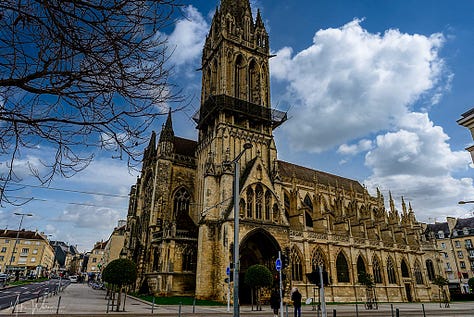
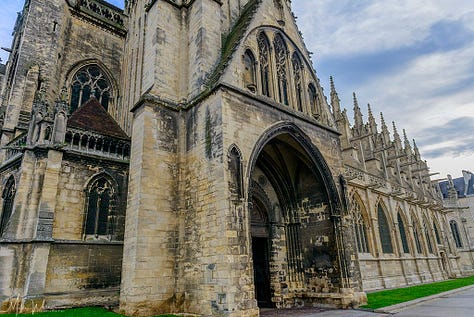
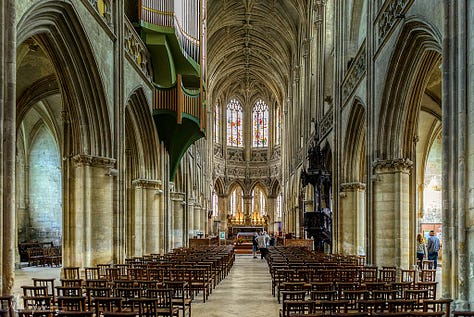


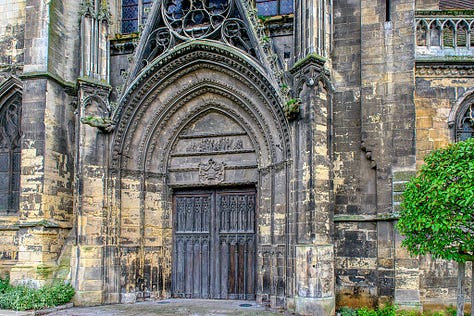
The Eglise Saint-Pierre de Caen is a notable church in the city of Caen.
Saint-Pierre Church is considered an architectural masterpiece and is one of the most important Gothic buildings in Normandy. Its construction started in the 13th century and was completed in the 16th century. The church was dedicated to Saint Peter, the apostle who is considered by Christian tradition as the first Pope.
One of the most striking features of Eglise Saint-Pierre is its facade, which is a brilliant example of the Flamboyant Gothic style. This facade features intricate designs and a large, beautiful rose window. Inside, the church is equally impressive, with a magnificent nave and choir.
The church is located near the ruins of Caen Castle, another significant historic site. This close proximity and the shared history between these two landmarks add to the appeal of the Eglise Saint-Pierre.
Click here to see where the Eglise Saint-Pierre is located on Google Maps
Eglise Saint-Étienne-le-Vieux
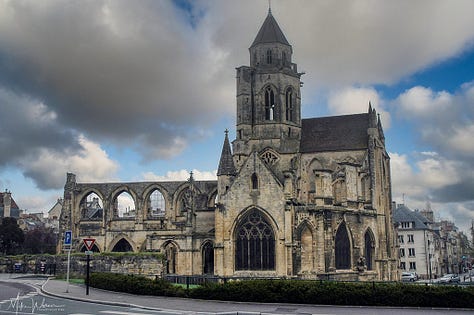
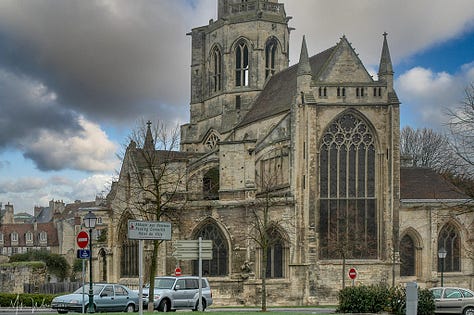
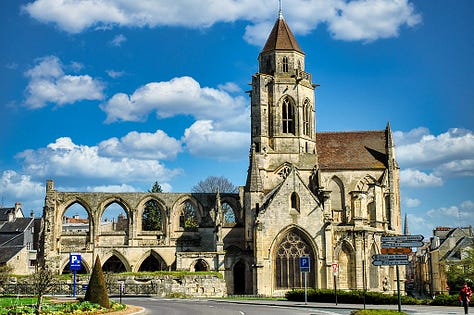
Église Saint-Étienne-le-Vieux (Church of Saint Stephen the Old) was a Romanesque church located in the city of Caen. The church dates back to the 11th century and was dedicated to Saint Stephen, who was the first Christian martyr. It was constructed using Caen stone, a local limestone that gives the buildings in the region their distinct appearance.
Unfortunately, the church suffered significant damage during World War II when Caen was heavily bombed in the Battle of Normandy. The bombardments destroyed a large portion of the city, including Église Saint-Étienne-le-Vieux. Today, only the ruins of the church remain.
The ruins of Église Saint-Étienne-le-Vieux are considered a historical and architectural attraction in Caen. Despite its damaged state, the remaining structure still showcases elements of Romanesque architecture, including arches, columns, and intricate stone carvings. The site serves as a reminder of the destruction caused by war and the resilience of historical heritage.
It's worth noting that there is another church called "Église Saint-Étienne" (Church of Saint Stephen) located in Caen as well. This church is different from Église Saint-Étienne-le-Vieux and is an active place of worship.
Click here to see where the ruins of the church are located on Google Maps
This are but a few of the many churches that you can see and visit in Caen.

